Editor’s Note: This is “Part 1” in a series on buying and selling products on the major marketplaces. This installment focuses on the buying experience.
eBay.com launched the first online marketplace back in 1995 with its large-scale auction platform. Amazon.com has since focused on selling new products from thousands of retailers and suppliers of all types. Rakuten’s Buy.com and relative newcomers like Sears.com and Newegg.com are targeting the same mass-market consumer with millions of products from thousands of sellers. From leather shoulder bags to HDMI video adapters, shoppers will typically find many choices, both new and used, on those sites.
Smaller marketplaces like Etsy.com, Bonanza.com, eCrater.com, and Handmade.com feature more specialized, one-of-a-kind products. These sites offer a channel to sell unique products that carry higher profit margins than larger marketplace sites.
For buyers, marketplaces contain a wide range of selections, brands, and price points. With the larger marketplaces, buyers are typically protected from fraud and abuse, as buyers are the customers, not the end sellers. If there is a dispute of any type, the odds are highly in a buyer’s favor. Buyers can also benefit from aggressive shipping policies, as well as highly competitive pricing.
For sellers, marketplaces deliver a huge potential market that most individual businesses could not reach. They can significantly increase your unit sales. But, unless you are selling your own branded products, profit margins will likely suffer, compared to selling on your own website. You cannot market directly to the buyers as they are not your customers, so you lose the future revenue potential you would have if they purchase from your website directly.
In this article, I’ll be focusing on the larger marketplaces from the buyers’ perspective. I’ll review Amazon.com, eBay.com, Sears.com, Newegg.com, and Buy.com, and evaluate each based on (a) how easy it is to find items, (b) overall selections, and (c) the shopping experience.
My wife’s leather shoulder bag in high on her holiday gift list, so I decided to shop for a leather shoulder bag on each site for this article.
Amazon.com
I don’t need to spend a lot of time talking about the user experience here. For many ecommerce sites today, Amazon has already established the standard for user experience. Overall, Amazon has as many products as you will find. They offer mass market as well as niche products, though the niche products tend to be hard to find through all the other items that are presented. I don’t think “unique, one of a kind product” when I shop at Amazon.
The checkout is a breeze, shipping options are clear throughout the entire experience. Overall, Amazon delivers a top-notch experience.
Amazon search results for "shoulder bags leather." Enlarge This Image
Enlarge This Image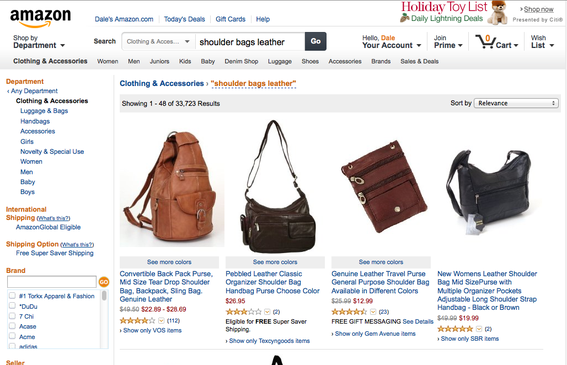
-
Pros. Huge inventory of 345 leather shoulder bags. Amazon’s faceted search can refine results by department, brand, seller, shipping, and other categories. A quick click to the product detail pages reveals user reviews, alternative images, other seller choices, related items, and detailed descriptions. The volume and quality of reviews on Amazon are superior to any other marketplace. I use Amazon to research products regularly.
-
Cons. In many categories, you will find so many items that it’s hard to filter through them. I’m not a fan of the advertisements for non-related products, preferring to focus on what I’m shopping for — not ads for electronics equipment when I’m look at leather bags.
—
eBay
eBay is still the largest online auction site, with a huge amount of sellers that specialize in used merchandise. eBay’s strategy, however, seems to focus on its “buy it now” transactions. You can find everything from beads to cars on eBay. Competitive pricing is a given.
eBay search results for "leather shoulder bags." Enlarge This Image
Enlarge This Image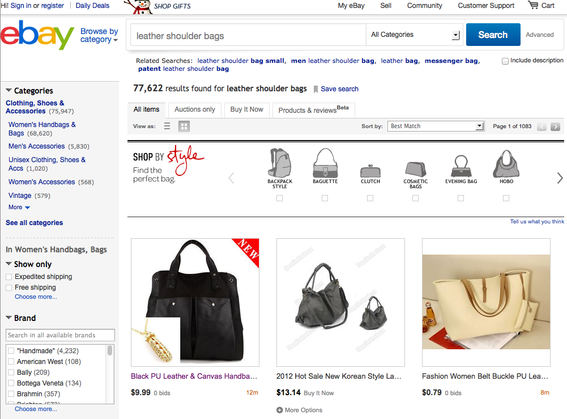
-
Pros. I like eBay’s search results page. The “shop by style” feature is handy. The search options help find what you are looking for. This is helpful since eBay has 77,000 results for “leather bags.” eBay also offers a “Low Price Guarantee” on millions of products.
-
Cons. Even using the search filters, I’m still at 2,000 types of leather bags. And the search results contain auction items, which is not useful for “buy it now” shoppers.
Sears.com
Sears has grown its marketplace presence significantly. It offers a wide selection of products from many sellers, including its own brands, like Lands End, Craftsman, and Kenmore.
Sears search results for "leather shoulder bags." Enlarge This Image
Enlarge This Image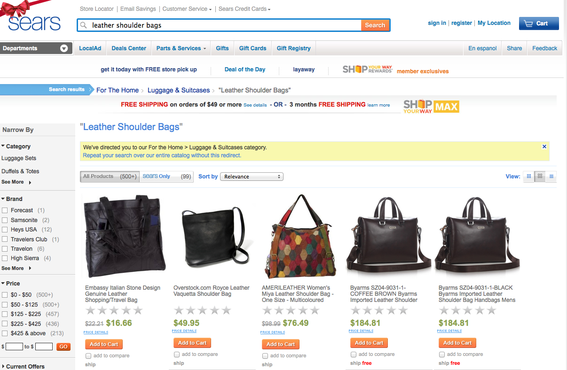
-
Pros. The search results are similar to Amazon’s and eBay’s. Searchers can refine results to just show Sears products, or marketplace sellers, or both. Sears offers several different product presentation templates that include easily accessible information about their marketplace sellers, including their phone number.
-
Cons. Sears does not have as many user reviews as Amazon. Many items I viewed contained blank stars.
—
Newegg.com
In the past, Newegg was primarily an electronics retailer. Today, it is a full range marketplace. To my surprise, I found 55 leather bags, though not all were shoulder bags. Expanding out from its loyal customer base makes sense for Newegg, as adding new sellers presumably carries little risk for its brand or business model. Many of the same sellers I saw in the other marketplaces are also selling on Newegg.
Newegg search results for "leather shoulder bag." Enlarge This Image
Enlarge This Image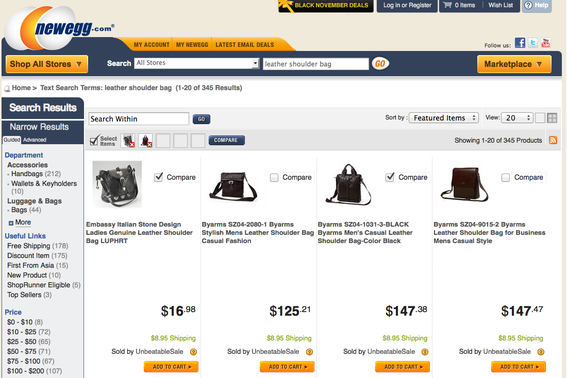
-
Pros. As with Sears, you can compare items. Newegg offer a nice thumbnail view of the items you are comparing. The layout is clean and simple, though not as elegant as some of the others. Their product detail page is very functional.
-
Cons. For now, there are not as many items as the other large marketplaces. The user interface, to me, contained wasted white space. The design was not as appealing as other sites.
—
Rakuten’s Buy.com
Buy.com offers a huge selection of merchandise and thousands of sellers. Buy.com encourages social buying by displaying what others are shopping for in real time, through its website and through an integration with Facebook. Buy.com offers a huge worldwide market for sellers.
Buy.com search results for "shoulder bags leather." Enlarge This Image
Enlarge This Image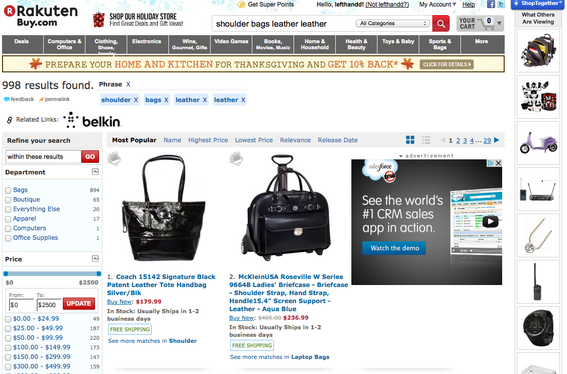
-
Pros. Buy.com contains many products. It offers good search filtering tools. The checkout process is easy and efficient.
-
Cons. There are too many non-related ads — see the Salesforce.com ad above in the product category page. The product detail page lacks the simplicity of other marketplace sites, as the page is very deep. It could use tabs to consolidate the information and help with browsing.





